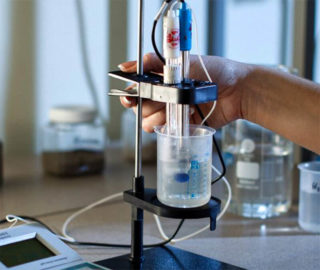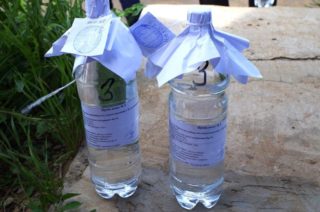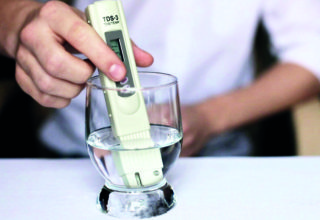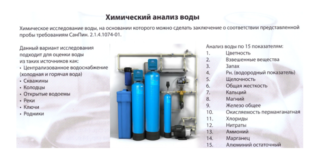Water is the most important and vital life-giving component in the body of any living being, including humans. Without high-quality and clean water, organs and systems will begin to "malfunction", possibly the development of diseases. Therefore, it is important to strictly monitor the quality of the fluid consumed. Water extracted from wells and wells has its own individual characteristics, which must be studied.
- Why do you need water analysis and where is it done
- Types of analyzes for the quality of water from a well
- How to take water for a sample correctly
- Features of the fence for microbiological research
- Features of checking water from a well for potability
- Is it possible to independently check the water from the well
Why do you need water analysis and where is it done

Regardless of the lifetime of the source and the volume of liquid consumed, it is recommended to do water analysis regularly. This is due to the continuous changes that occur with groundwater. It is good if the reason for this is exclusively natural factors - melting snows and downpours, floods, changing seasons. But human activity can also be to blame.
- Before you start drilling a well, you need to find a suitable place that fully meets all the requirements of SNiP and SanPiN. If the optimal distance between the sewer system and the well has not been maintained, waste water can penetrate into the clean liquid.
- Due to large-scale transport accidents, the work of industrial enterprises and the emergency collection of chemical waste, the soil is saturated with a large amount of toxic substances, which gradually reach the aquifers.
A large number of such examples can be cited. The danger also lies in the fact that it is not always possible to determine the composition change by eye and taste.
The instructions for safe water intake require water analysis at least once a year.
Special firms do such analyzes. It is better to give preference to those who are able to carry out a full comprehensive check. It is also important what kind of feedback about the work can be observed. Often, such laboratory studies are carried out by firms specializing in water purification filters.
Types of analyzes for the quality of water from a well
- standard;
- extended;
- microbiological.
The first method is to check wells, the depth of which exceeds 25 meters. An extended estimate of well water indicators is determined in springs less than 25 meters deep. An extended check is required to obtain a detailed analysis result, due to the fact that the highest concentration of harmful impurities falls into the first aquifer.
If it is a shallow source, microbiological analysis is required. Laboratory research makes it possible to determine not only the chemical composition of the well fluid, but also the presence of microorganisms and bacteria in it, which have a detrimental effect on human health.
The latter type of analysis is best done after heavy rainfall when the groundwater level has risen.
During the assessment of the condition of the liquid, the total content of foreign impurities and bacteria is calculated.The concentration of coliform bacteria will determine whether such water is generally usable.
How to take water for a sample correctly

To bring a high-quality sample to the laboratory, several important rules for taking water must be observed:
- The liquid must be collected in transparent sterile containers, the total volume of which will be at least 2 liters. More is possible, less is impossible.
- It is recommended to pre-rinse the collection tank in the same water. In this case, no detergents and cleaning agents can be used.
- It is preliminarily recommended to pump out a small amount of liquid so that the liquid that has been in the pipeline for a certain time does not go to the laboratory.
- The set is carried out with a thin stream, which should flow down the walls of the prepared container. This is necessary in order not to saturate the liquid with oxygen, which will immediately affect the results of the studies carried out.
- The sampling is carried out directly under the neck of the container, otherwise the bottle will be saturated with oxygen and the well liquid too.
It is required to deliver the material to the laboratory no later than three hours from the moment of its collection. If you neglect this rule, the results of laboratory tests will be greatly distorted. It is better to store it in the refrigerator until delivery.
Features of the fence for microbiological research
- Treat hands before contact with liquid with disinfectants.
- For the collection of material, only sterile containers are used, which were previously taken in the laboratory.
- Carefully remove the gauze cover from the container. It is strongly not recommended to touch the neck with your hands.
- The intake of liquid is carried out under the neck, the container is tightly closed with a rubber stopper.
- The container records data on the date and time of collection of the material.
- Water must be handed over to the laboratory no later than two hours after collection. If this is not possible, store it in a cold place, but no more than 6 hours.
There is a special kit for performing express analysis of liquid, which can be purchased from firms specializing in cleaning filters. Doing such an analysis at home, the results will be shown within 10 minutes.
Features of checking water from a well for potability
Organizations with a good reputation, as a rule, send their specialists, who independently collect material. This gives a 100% guarantee that the chemical composition of the substance will not undergo transformations and changes.
The liquid is collected in two different but sterile containers. The first flask is used to check the quality as well as the presence of inorganic ingredients. The second is required for the analysis of the microbiological component.
According to GOST rules, well water should not contain any bacteria and pathogenic microorganisms.
The first should be a biological analysis, since the lifespan of some organisms is limited. Next, they begin to carry out the biochemical component. The contract must strictly stipulate the terms for the submission of a report on the analysis of the liquid. The results are an official document certified by the seal of the organization. It may also contain recommendations for improving the quality of well water in a particular case.
Typically, large organizations provide responses within a few weeks. From small laboratories, the result can be expected up to several weeks.
Is it possible to independently check the water from the well

The water extracted from the well can be checked for the presence of third-party impurities in its composition at home. Pour clear liquid into a clean glass container and look at it through sunlight. If the liquid is cloudy and various solid floating particles are visible in it, this indicates the inclusion of flakes of bacteria and microorganisms, iron, sand, salts, etc. Typically, the color ranges from light yellow to brown. If, when shaking the container, the liquid becomes cloudy, it is likely that the composition is oversaturated with dissolved iron.
Milky fog indicates oversaturation of the composition with gases. Potassium permanganate - manganese can give a gray and black tint.
The cost of analyzing water from a well fluctuates in quite wide ranges, depending on the region. The average price in Russia is 5-6 thousand rubles.











